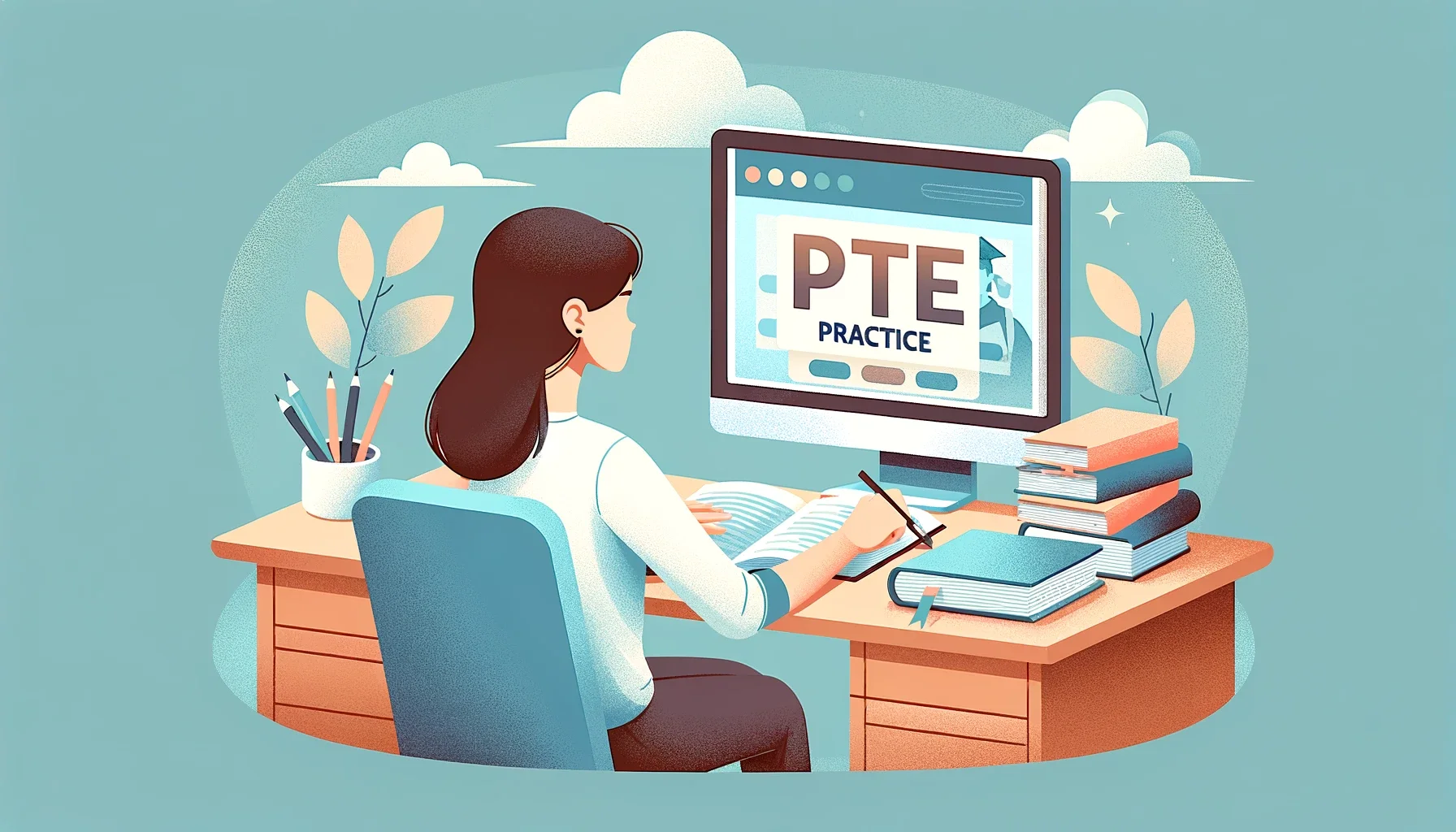Mastering the Read Aloud task in PTE Core is not just about passing an exam; it's about unlocking global communication opportunities.
Dive into the essence of language mastery with PTE Core Speaking Section's Read Aloud question-type, a pioneering approach designed for educators. With the power of integrating speaking and reading skills, offer a unique pathway for students to excel. Genebyte's cutting-edge solutions empower teachers to elevate their instructional methods, ensuring students not only achieve high scores but also master real-world communication. Explore how Read Aloud in PTE Core can redefine language learning in your institute.
In today's globalized environment, effective communication in English is not just a skill but a necessity. The PTE Core's Read Aloud question-type serves as a cornerstone in this context, specifically designed to assess and enhance an individual's ability to read and speak English fluently. Our objective is to delve into how this question-type benefits educators and learners alike by focusing on real-world linguistic applications. By exploring Read Aloud in PTE Core, we aim to empower teachers with the knowledge to better prepare their students for the challenges of global communication, ensuring they not only excel academically but also thrive in professional and social settings.

Introduction to Read Aloud in PTE Core
Brief Overview of the PTE Core Exam
The PTE Core exam, a cornerstone in assessing English language proficiency, provides a comprehensive measure of a candidate's ability to engage with the language in real-world scenarios. It's designed with a focus on practical communication skills, encompassing speaking, writing, reading, and listening abilities.
Significance of the Read Aloud Question-Type in Language Assessment
Among its varied question types, Read Aloud stands out for its dual focus on reading and speaking skills. This unique component challenges test-takers to demonstrate fluency, pronunciation, and comprehension by reading a given text aloud. It's not just about accurate reproduction of words but also about the rhythm, intonation, and stress that mirror natural speech patterns.

The Mechanics of Read Aloud in PTE Core
Description of the Task and Expectations
Every PTE Core test starts with an unscored Personal Introduction, followed by the official commencement of the speaking section with the Read Aloud task, which is designed to assess both reading and speaking skills, serving as a critical component of the exam that reflects a candidate's ability to read a text and reproduce it verbally in an accurate, fluent manner. This task directly impacts the proficiency indicators for reading and speaking, showcasing the holistic approach of PTE Core in evaluating language skills.
In this task, candidates are presented with a text on their screen, which they must read aloud into the microphone. The primary expectation is for candidates to demonstrate clear pronunciation, fluidity in speech, and the ability to maintain the natural rhythm of the English language. It is not just about reading the words correctly but also about conveying them with proper intonation and stress, which are key to effective communication in English.
Breakdown of Prompt Length and Time Allocation for Responses
- Prompt Length: The texts for the Read Aloud tasks vary in length, typically ranging from 30 to 60 words. This variability ensures that candidates can demonstrate their reading and speaking skills across different contexts and difficulties.
- Preparation Time: Upon being presented with the text, candidates have approximately 30 to 40 seconds to familiarize themselves with it before the recording begins. This preparation time is crucial for candidates to mentally prepare and strategize their reading approach.
- Recording Time: The actual time allocated for reading the text aloud varies depending on its length but is generally around 30 to 40 seconds. This time frame is designed to mimic real-life scenarios where individuals may need to read aloud documents or presentations in a professional setting.
Skills Assessed Through Read Aloud: Reading and Speaking
- Reading Skills:
- Content: Ability to read words correctly.
- Speaking Skills:
- Fluency: Smoothness and flow of reading without unnecessary hesitations or interruptions.
- Pronunciation: Clarity and correctness in articulating words, which is essential for effective communication.
- Intonation and Stress: Use of pitch and emphasis to convey meaning and expressiveness in speech.
For coaching institutes utilizing Genebyte's platform, this task presents an excellent opportunity to refine their training programs. By focusing on the Read Aloud task, trainers can help their students improve not just their exam scores but also their general English communication skills.

The Importance of the Read Aloud Item-type in PTE Core
The Read Aloud item-type in PTE Core stands as a cornerstone for both students and teachers navigating the path to English proficiency. This particular question-type is designed not merely as a test of speaking ability but as a comprehensive tool that significantly impacts both the PTE Core Speaking and Reading scores.
Impact on PTE Core Speaking Score
At Genebyte, we recognize the multifaceted value of the Read Aloud item-type. It tests students on several fronts: fluency, pronunciation, and the ability to read and speak simultaneously. This makes it an indispensable part of our coaching software, specifically tailored to enhance these skills among learners.
For teachers, understanding the intricacies of Read Aloud tasks is crucial. Our platform provides detailed analytics and insights into each student's performance, enabling teachers to identify areas of improvement quickly. For instance, if a student struggles with fluency, our software highlights this, allowing for targeted practice sessions.
Influence on PTE Core Reading Score
Interestingly, the Read Aloud question-type also influences the Reading score. This is because it assesses the ability to understand and speak content accurately.
To illustrate the effectiveness of focusing on Read Aloud tasks, consider the following real-life example:
| Student Profile | Before Using Genebyte | After Using Genebyte |
|---|---|---|
| Fluency | Average | Significantly Improved |
| Pronunciation | Needs Improvement | Improved |
| Content | Struggling | Enhanced |
This table showcases a typical improvement trajectory for students engaging with our Read Aloud focused curriculum. By integrating our software, teachers can offer a more personalized learning experience, ensuring that each student's unique needs are addressed.

Strategies for Educators
Encouraging Effective Practice
At Genebyte, we are deeply invested in the success of both educators and students navigating the path of English proficiency exams like PTE Core. A critical aspect of this journey involves the 'Read Aloud' section, a fundamental component designed to assess a candidate's ability to read and pronounce words accurately, reflecting real-world communication skills.
To enhance educator efficacy and student outcomes, we advocate a strategic approach that transcends the mere use of templates. While templates offer a structured method for responding to various question types, they may not always promote the depth of learning required for genuine language acquisition. Instead, we emphasize the importance of fostering an environment where students engage with the material dynamically, focusing on pitch and pace meters as tools to refine their reading and speaking abilities.
Enhancing Educator Efficacy and Student Outcomes with Pitch and Pace Meters
Pitch and pace are crucial in the Read Aloud question-type, affecting the naturalness and understandability of spoken English. Our platform introduces innovative features enabling educators to guide students in mastering these aspects:
- Pitch Meter: This tool helps students visualize their pitch, encouraging them to maintain a natural and varied tone that mimics conversational English. By practicing with real-time feedback, students can adjust their intonation, improving their overall speaking fluency.
- Pace Meter: Equally important is the pace at which students read aloud. Our pace meter assists in finding the optimal speed—neither too fast to compromise clarity nor too slow to sound unnatural. This balance is critical for the Read Aloud section, where comprehension and fluency are judged together.
Benefits of Focusing on Pitch and Pace
| Benefit | Description |
|---|---|
| Improved Fluency | Students learn to speak English more naturally, mirroring the rhythm and intonation patterns of native speakers. |
| Enhanced Comprehension | A well-paced delivery ensures that students can be easily understood, promoting better communication. |
| Higher Engagement | Interactive tools like pitch and pace meters make learning more engaging, encouraging students to practice more frequently. |
| Better Scores | Mastery of pitch and pace directly contributes to higher scores in the Read Aloud section, reflecting improved language proficiency. |
Prepare Students for Global Communication Challenges
Our approach at Genebyte aims not only to prepare students for the PTE Core exam but also to equip them with skills essential for global communication challenges. By focusing on natural speech patterns and effective delivery, educators can help students become confident English speakers, ready to thrive in any academic or professional setting.

The Limitation of Templates in the Read Aloud Task-type
In the realm of PTE Core preparation, the Read Aloud question-type stands as a critical component, testing a candidate's fluency, pronunciation, and the ability to read a text aloud in a natural and coherent manner. As part of Genebyte's suite of solutions, we have meticulously analyzed the efficacy of various strategies employed by teachers and students alike. A topic of considerable debate among educators is the use of templates or tricks in navigating the Read Aloud tasks. Here, we delve into the limitations of such approaches and advocate for a more holistic strategy.
Understanding the Read Aloud Task
The Read Aloud task in PTE Core is designed to mimic real-world scenarios where clear and accurate spoken communication is essential. It involves reading a text aloud, which is evaluated by sophisticated AI algorithms for several parameters, including fluency and pronunciation. This task not only assesses one's speaking abilities but also their reading skills, making it a multifaceted challenge.
The Issue of Over-Reliance on Templates
While templates and memorized strategies can offer a crutch, they fall short for several reasons:
- Lack of Flexibility: Templates do not account for the diversity of texts encountered in the Read Aloud task. Each passage presents its unique set of challenges, requiring a nuanced understanding and approach.
- Artificial Fluency: Over-reliance on rehearsed strategies can lead to a form of artificial fluency, where the speech does not sound natural or engaging. This can negatively impact the fluency and pronunciation scores, which are pivotal in the Read Aloud task.
- Misalignment with Scoring Criteria: The AI scoring system of PTE Core is designed to evaluate natural language use. An overly templated response may not align well with the criteria set forth for scoring, potentially leading to lower scores.
A Strategy Beyond Templates
Genebyte’s platform emphasizes a comprehensive approach to mastering the Read Aloud task, focusing on the development of core skills rather than shortcuts. Our strategy includes:
- Practice with Diversity: Providing a wide array of practice passages that reflect the variety seen in actual exams, enabling students to adapt their reading and speaking skills to any content effectively.
- Real-Time Feedback: Leveraging AI-powered analysis to offer instant feedback on pronunciation, fluency, and intonation, helping students refine their natural speaking style.
- Skill Building Exercises: Incorporating exercises that enhance reading speed, comprehension, and vocal clarity, ensuring that students are well-prepared for the demands of the Read Aloud task.
Strategies for Read Aloud Success
| Strategy | Description | Benefit |
|---|---|---|
| Diverse Practice | Engaging with a broad spectrum of texts. | Enhances adaptability and comprehension. |
| AI Feedback | Receiving instant evaluations on key performance metrics. | Allows for targeted improvements. |
| Skill Enhancement | Focused exercises on improving fluency and pronunciation. | Builds a solid foundation for natural speech. |

Leveraging Genebyte’s Solutions for Enhanced Teaching
Emphasizing Authentic Practice and Skill Development
In the realm of PTE Core preparation, the 'Read Aloud' question type stands as a significant challenge for students, testing their ability to read a text aloud in English accurately and fluently. This task not only evaluates their pronunciation and intonation but also their reading and speaking skills simultaneously. Genebyte's B2B SaaS solution is uniquely positioned to assist coaching institutes in enhancing their teaching methods specifically tailored to conquer this challenge.
Our platform offers an array of features designed to provide authentic practice environments that mirror the actual PTE Core exam conditions. By utilizing our software, institutes can offer their students opportunities to engage in simulated 'Read Aloud' exercises that are critically evaluated by AI-driven technologies, ensuring feedback that is both immediate and precise.
Features of Genebyte’s Software Beneficial for 'Read Aloud' Preparation
- Simulated Practice Sessions: Our software replicates the PTE Core testing environment, allowing students to practice the 'Read Aloud' question type under exam-like conditions. This helps in reducing test anxiety and improving their confidence.
- AI-Powered Feedback: Leveraging advanced AI, our platform provides instant feedback on pronunciation, fluency, and pacing, enabling students to identify and work on their weaknesses effectively.
- Comprehensive Analytics Dashboard: Teachers and students gain access to detailed performance analytics, highlighting areas of strength and those needing improvement. This data-driven approach facilitates targeted skill development.
- Customizable Content: Institutes can customize practice materials to focus on commonly difficult passages or words, tailoring the learning experience to meet students' specific needs.
Impact of Genebyte’s Solutions on 'Read Aloud' Performance
| Feature | Benefit |
|---|---|
| Simulated Practice Sessions | Mimics real exam conditions, reducing anxiety |
| AI-Powered Feedback | Provides instant, actionable feedback |
| Comprehensive Analytics Dashboard | Enables targeted skill development |
| Customizable Content | Tailors practice materials to student needs |

Actionable Tips for Maximizing Success in Read Aloud
As we navigate the intricacies of preparing students for the PTE Core exam, particularly the Read Aloud question-type, it becomes evident that success hinges on more than just familiarity with the test format. It requires a deep dive into authentic practice, precise feedback, and strategic skill development. Herein lies the unmatched value of Genebyte's B2B SaaS solution, meticulously designed to empower coaching institutes and their educators with cutting-edge tools and insights.
- Incorporate Diverse Practice Materials: Utilize Genebyte’s extensive library of texts to expose students to a variety of topics and vocabulary, enhancing their adaptability and comprehension.
- Leverage AI-Driven Feedback: Make the most of real-time, AI-powered feedback on pronunciation and fluency to offer personalized coaching that targets each student's specific needs.
- Analyze Performance Analytics: Regularly review comprehensive analytics provided by Genebyte’s platform to track progress and adjust teaching strategies accordingly.
- Focus on Skill Development: Beyond exam preparation, emphasize the development of real-world English communication skills, preparing students for global opportunities.
The journey to mastering the Read Aloud question-type in PTE Core is complex, yet immensely rewarding. After this question-type, student goes to the Repeat Sentence task, which is equally important. RA embodies the essence of language learning — not just to pass an exam but to communicate effectively in a global context. Genebyte stands at the forefront of this journey, offering a suite of solutions that bridge the gap between traditional teaching methods and the demands of modern language assessment. As we conclude, let us remember that the goal is not just to prepare students for a test but to equip them with the skills necessary for success in any English-speaking environment.
Genebyte invites coaching institutes to experience a paradigm shift in PTE Core preparation. By integrating our SaaS solutions, educators can elevate their teaching methods, ensuring students not only excel in the Read Aloud task but also gain confidence in their English language abilities. Our commitment to enhancing language education through technology is unwavering, and we are dedicated to partnering with institutes in their mission to achieve excellence.
Frequently Asked Questions
The scoring for Read Aloud in PTE Core focuses on fluency, pronunciation, and the ability to convey the text's content effectively. Accuracy in reading, pacing, and intonation are key factors evaluated.
Using templates is not advisable for Read Aloud tasks as they require genuine comprehension and natural speech patterns. Instead, focusing on improving fluency and pronunciation through practice is recommended.
Omitting words can negatively affect your score. It's crucial to practice reading and speaking the text as accurately as possible to maintain the integrity of the content.
Guidelines include practicing with diverse texts, focusing on natural pacing, and improving pronunciation. Utilizing tools like pitch and pace meters can also help refine speaking skills.
Enhancing Read Aloud skills involves regular practice with varied texts, utilizing feedback on pronunciation and fluency, and engaging in exercises to improve speaking and reading abilities.
This task assesses both reading and speaking skills, evaluating the ability to read a passage aloud clearly, fluently, and accurately.
Yes, unnatural pausing can impact fluency scores. It's important to practice speaking at a natural and consistent pace.
Managing pacing involves practicing with a timer and becoming familiar with speaking at a steady, natural rate. Feedback tools can help identify pacing issues.
Fluency is a critical component of the scoring for Read Aloud, with smooth, natural delivery being key to achieving higher scores.
Yes, pronunciation errors can lead to lower scores. It's essential to focus on clear and correct pronunciation during preparation.
Tips include reading aloud regularly, recording and listening to your practice sessions, and using feedback tools to improve.
Pitch and pace significantly influence the naturalness and understandability of speech. A varied pitch and steady pace can enhance fluency and pronunciation scores.
Preparation should involve practicing with texts of varying lengths and complexities to build adaptability and improve overall reading and speaking skills.
